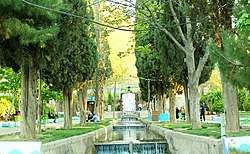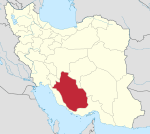Estahban
| Estahban استهبان | |
|---|---|
| City | |
 | |
 Estahban | |
| Coordinates: 29°07′36″N 54°02′32″E / 29.12667°N 54.04222°ECoordinates: 29°07′36″N 54°02′32″E / 29.12667°N 54.04222°E | |
| Country |
|
| Province | Fars |
| County | Estahban |
| Bakhsh | Central |
| Population (2016 Census) | |
| • Total | 36,410 [1] |
| Time zone | UTC+3:30 (IRST) |
| • Summer (DST) | UTC+4:30 (IRDT) |
| Area code(s) | 071-53 |
| Website | estahban.ir |
Estahban (Persian: استهبان, Arabic: اصطهبانات, also Romanized as Estahbān and Eşţahbān; formerly, Eşţahbānāt, Estehbanat, Istehbānāt, Istahbanát[2] and Shahr-e Eşţahbānāt; also formerly known as Savānāt)[3] is a city and capital of Estahban County, Fars Province, Iran.
The area about Estahban is very fertile,[2] being the largest producer of dried fig, saffron, grain, cotton, walnut, almond, grapes and other fruits in the middle east. Estahban has been the most famous provider of figs to the world. It is also one of the biggest producers of saffron. Its original name Estahbanat was changed to Estahban in 1970.
In history, Estahbanat was called by Farsname Naseri. It is rooted from Pahlavi word of "Seteh" and suffix "Ban" which mean place for keeping grapes.
Demographics
Language and ethnic groups
The majority of the people of Estahaban are Persians, and they speak Persian with Shirazi accent different from Persian accent of Tehran.
Religion
The majority of people in Estahban are Muslims.
Population
According to the Iranian Census of 2011 the population of Estahabn is 66,172 people from 12,714 families, which includes 32,654 women and 33,518 men.
Geography
Estahban is located at 29.1291° N , 54.358° E and surrounded by Bakhtagan Lake from north, by Fars township from suoth and by Shiraz and Darab from west and its average elevation from sea level is about 1767 m.
Climate
Estahban is a dry City, with a yearly precipitation amount of 224 millimeters, with summer temperatures frequently about 28.1 °C (104 °F) in blazing sunshine with no humidity.
Economy
Because of fertile soil, economy in Estahban is mostly based on agriculture and consequently significant portion of population is employed in agriculture industries. Estahaban dried fig is a unique product all around the world.
Dry Fig
Growing rain-fed and organically, having sweeter taste, drying naturally on tree and lots of health benefits are some of features which made this fig a unique fruit.
There is no process for drying this product. Figs become dried by sun lights on the tree and then fall on the earth. farmers collect them to warehouse to classify them.
Notables from Estahban
References
- ↑ https://www.amar.org.ir/english
- 1 2

- ↑ Estahban can be found at GEOnet Names Server, at this link, by opening the Advanced Search box, entering "-3062411" in the "Unique Feature Id" form, and clicking on "Search Database".
| Wikimedia Commons has media related to Estahban County. |
